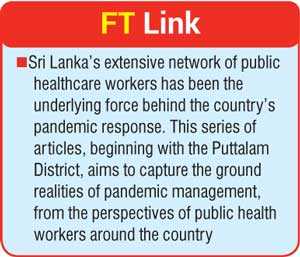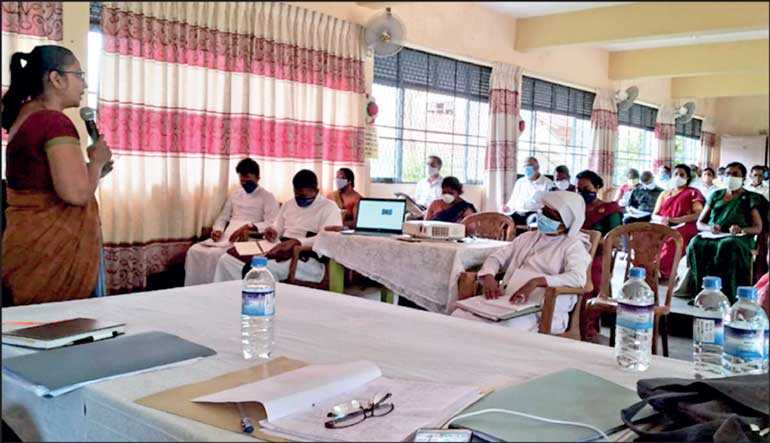Thursday Apr 17, 2025
Thursday Apr 17, 2025
Saturday, 23 January 2021 00:28 - - {{hitsCtrl.values.hits}}

Sri Lanka's wide network of public health workers has been the backbone of the country's COVID response – Pic by Ruwan Walpola
The pandemic in Puttalam
“COVID 19 came to Puttalam before it reached other parts of the island,” says Consultant Community Physician Dr. Thushani Dabrera, focal point for Puttalam’s COVID 19 response strategy.
The Puttalam District, situated in the North Western Province, has felt the full force of the pandemic and health workers in Puttalam were among the first to join the frontlines.
Having worked as an epidemiologist in Puttalam since 2007, Dr. Dabrera knew the district well. She knew its people, its geography, its unique customs, and most importantly its public healthcare network. “Puttalam has had a somewhat different experience with the pandemic, due to certain unique risk factors in this region,” says Dr. Dabrera, adding, “to cope, our strategy had to be a little different as well.”
Risk management and early response
Puttalam began its pandemic response in January 2020, before the COVID-19 panic had reached the rest of the country, and before the WHO had declared a global pandemic. On 15 January a group of Chinese engineers returned to work in Puttalam after spending the New Year in China.
At the time, Sri Lanka had not introduced large-scale prevention measures, and quarantine and testing facilities had not yet been established. Though they showed no symptoms, district health officials decided to take extra precautions by quarantining the returnees, and by introducing small-scale management and prevention measures in the area. Hospitals were equipped with essential provisions, and staff were educated on how to identify COVID 19 symptoms.
By February, a second risk factor was identified. The town of Wennappuwa, commonly known as ‘little Italy’ is home to the highest number of Sri Lankans employed in Italy, and as the pandemic reached its peak in Italy many Sri Lankans started returning home to Puttalam.
In the months of February and March around 2,500–3,000 people returned to Puttalam from Italy, and many had COVID-19 symptoms. Though foreign returnees were required to self-quarantine at home, the seriousness of the situation had not yet been understood and enforcing quarantine was a struggle.
The situation was exacerbated by the annual Thalawila Church feast which generally attracts a crowd of around 200,000. “We are talking of a population of around 100,000 in a 10-20 acre area. The Quarantine Act had not yet been gazetted and it was very difficult for us to enforce quarantine during this period,” explains Dr. Dabrera.
Puttalam, at the time, had no dedicated isolation facility and authorities realised early on that the high case load in the district would overwhelm the hospital capacity. Recognising the need for a separate isolation facility, district authorities identified a 540-acre unutilised property situated in a very isolated area. The property, acquired under the Quarantine Ordinance in March was converted into the Iranawila Hospital within 20 days.
On 14 March the first positive COVID-19 case was reported from within the district. Contact tracing efforts began immediately after and on 18 March curfew was officially declared in the area.
In Puttalam, like in many other areas of the country, local communities supported authorities in whatever way they could. “When we didn’t have enough PPEs, people got together, sourced the materials and stitched masks at home. Religious leaders at temples, convents, mosques, kovils, all made masks,” says Dr. Dabrera.
By end March, the district was fully self-sufficient in PPEs, she adds, and measures were taken to provide essential supplies to vulnerable households. “Everyone had a part to play – the political authorities, the police, the armed forces, religious leaders, the business community, civil society organisations – we all worked as a team, and we had good leadership from the Regional Director of Health Services, Dr. Dinusha Fernando, Regional Epidemiologist Dr. Udani Adikary and the District Secretary, Mr. Chandrasiri Bandara. Advocacy, good leadership, and firm and timely decision making have been instrumental in this process,” says Dr. Dabrera.
Facing the second wave
Since October, Puttalam has been hit hard by the second wave of infection surrounding the Minuwangoda garment factory cluster and the Peliyagoda fish market cluster in the neighbouring Gampaha District.
People move frequently between the two districts since many garment factory workers commute to work from Puttalam, and fishermen in the area have close contacts with the Peliyagoda fish market. Though contact tracing helped control the spread to some extent several areas in the district had to be isolated.
Managing the second wave has been a challenge, and Dr. Dabrera now sees some bottlenecks in the strategy. “Laboratories are overburdened, and there is no system to prioritise tests,” she says, explaining that the time and effort spent on coordinating the testing process is exacerbated by the lack of a dedicated laboratory for PCR testing in the North Western Province.
In light of the second wave, Dr. Dabrera sees the need for review and reassessment. “We need to look back and see where we could have done better. Moving forward, all sectors need to be involved in making a plan. Guidelines alone won’t help if implementation is not up to standard,” she says.
Systemic issues aside, the course of the pandemic will also be determined by public behaviour. “We need to keep the country open to maintain our economy but we can’t do this unless people limit their movements. There is no official curfew but we need to act as if there is,” says Dr. Dabrera.
The World Bank-funded COVID-19 Emergency Response and Health Systems Preparedness Project is supporting Sri Lanka’s Test, Trace, Treat strategy. In addition to contributing to the country’s supply of essential medical items, testing kits and PPEs, the project is supporting contact tracing efforts and maintaining 32 quarantine centers around the country.
 In terms of pandemic preparedness, the project is working towards strengthening the country’s emergency response capacity. Activities are focused on strengthening the National Emergency Operations Unit and its island wide network, strengthening the national epidemiological diseases surveillance system, developing selected hospitals as pandemic response centres, and strengthening the local laboratory network.
In terms of pandemic preparedness, the project is working towards strengthening the country’s emergency response capacity. Activities are focused on strengthening the National Emergency Operations Unit and its island wide network, strengthening the national epidemiological diseases surveillance system, developing selected hospitals as pandemic response centres, and strengthening the local laboratory network.
The project is also addressing some of the social consequences of the pandemic by providing financial assistance to vulnerable populations, by strengthening mental health services and by providing services to victims of gender-based violence.

Dr. Thushani Dabrera conducting an awareness session for public sector officials at the Divisional Secretariat Office in Wanathawilluwa – Pic by Dr. Dinej Chandrasiri
Discover Kapruka, the leading online shopping platform in Sri Lanka, where you can conveniently send Gifts and Flowers to your loved ones for any event including Valentine ’s Day. Explore a wide range of popular Shopping Categories on Kapruka, including Toys, Groceries, Electronics, Birthday Cakes, Fruits, Chocolates, Flower Bouquets, Clothing, Watches, Lingerie, Gift Sets and Jewellery. Also if you’re interested in selling with Kapruka, Partner Central by Kapruka is the best solution to start with. Moreover, through Kapruka Global Shop, you can also enjoy the convenience of purchasing products from renowned platforms like Amazon and eBay and have them delivered to Sri Lanka.
Discover Kapruka, the leading online shopping platform in Sri Lanka, where you can conveniently send Gifts and Flowers to your loved ones for any event including Valentine ’s Day. Explore a wide range of popular Shopping Categories on Kapruka, including Toys, Groceries, Electronics, Birthday Cakes, Fruits, Chocolates, Flower Bouquets, Clothing, Watches, Lingerie, Gift Sets and Jewellery. Also if you’re interested in selling with Kapruka, Partner Central by Kapruka is the best solution to start with. Moreover, through Kapruka Global Shop, you can also enjoy the convenience of purchasing products from renowned platforms like Amazon and eBay and have them delivered to Sri Lanka.